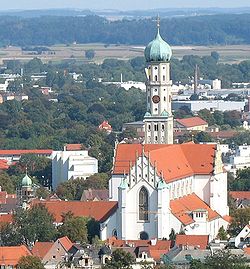St. Ulrich's and St. Afra's Abbey (Augsburg)
| Imperial Abbey of Saints Ulrich and Afra, Augsburg | ||||||||||||
| Reichskloster Sankt Ulrich und Afra in Augsburg | ||||||||||||
| Imperial Abbey | ||||||||||||
|
||||||||||||
|
The abbey of Saint Ulrich and Saint Afra
|
||||||||||||
| Capital | St Ulrich's and St Afra's Abbey | |||||||||||
| Government | Elective principality | |||||||||||
| Historical era | Middle Ages | |||||||||||
| • | Founded | ca 10th century | ||||||||||
| • | Gained immediacy | 1577 | ||||||||||
| • | Immediacy accepted by Bp Augsburg |
1643/44 |
||||||||||
| • |
Secularised to Augsburg (Imp. City) and Bavaria |
1802 | ||||||||||
| • | City mediatised to Bavaria | 1803 | ||||||||||
|
||||||||||||
| Today part of |
|
|||||||||||
| a: De jure b: De facto |
||||||||||||
St. Ulrich's and St. Afra's Abbey, Augsburg (German: Kloster Sankt Ulrich und Afra Augsburg) is a former Benedictine abbey dedicated to Saint Ulrich and Saint Afra in the south of the old city in Augsburg, Bavaria.
From the late 16th century onward, the Abbey of St. Ulrich and St Afra was one of the 40-odd self-ruling imperial abbeys of the Holy Roman Empire and, as such, was a virtually independent state. The territory of that state was very fragmented: the abbey of St. Ulrich and St Afra proper enclaved within the Free Imperial City of Augsburg, and several small territories disseminated throughout the region. At the time of its dissolution in 1802, the Imperial Abbey covered 112 square kilometers and had about 5,000 subjects.
The Benedictine monastery was preceded by an original foundation established at an uncertain date, but at least as early as the 10th century (and in its turn quite possibly a refoundation of a still earlier one from the 5th or 6th centuries), by the "Kollegiatstift St. Afra", a community of the priests charged with the care of St Afra's Church (now the Basilica of Saints Ulrich and Afra), where the relics of Saint Afra were venerated, and next door to which the community premises were built.
Between 1006 and 1012, Bruno, Bishop of Augsburg, removed the canons to the cathedral chapter and gave the premises to Benedictine monks whom he brought from Tegernsee Abbey, thus turning it into a Benedictine monastery. It was granted Imperial immediacy (German: Reichsfreiheit) as an Imperial abbey in 1577, but this status was bitterly contested by the bishops of Augsburg, and the legal conflict was resolved in favour of the abbey only in 1643/44.
The abbey was dissolved in 1802 during the secularisation of Bavaria. The city of Augsburg and the state of Bavaria divided its territory between them. The monks however were permitted to remain in the premises of the dissolved monastery. In 1805 a French military hospital was installed here; after six monks, including the abbot, had died of infectious diseases, the remainder moved into a private house. The hospital was replaced in 1807 by a Bavarian cavalry barracks, known as the "Ulrichskaserne".
...
Wikipedia


